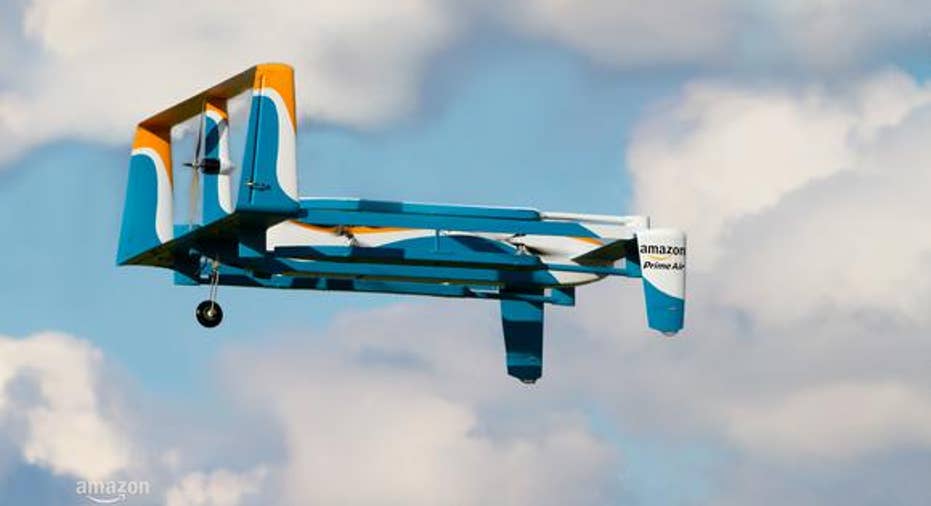Crash Test Drones: Are Amazon's Unmanned Delivery Vehicles Getting Closer?

As it leads the charge for legalizing delivery drones, one of the biggest challenges facing Amazon is the creation of a statutory language to consider them under.
Not quite planes, not quite helicopters, the unmanned flying vehicles actually have a lot in common with high-end toys used for years by radio control (RC) hobbyists. However, flying a drone over an empty field with some other RC enthusiasts brings a lot less risk than unleashing them in populated areas to make deliveries.
Emerging rules have begun to deal with some of the problems delivery drones could present. Now, a Federal Aviation Administration (FAA) committee has released a new set of recommendations for the next steps toward making theunmanned aircraft systems (UAS) legal. This is huge progress toward creating rules under which unmanned flying crafts for deliveries can become a reality. This idea is not unique to Amazon. Other companies considering using unmanned delivery drones include Wal-Mart andAlphabet's Google.
Amazon has released pictures of its drone prototype. Image source: Amazon.
What did the FAA committee decide?The Micro UAS Aviation Rulemaking Committee, the FAA group charged with tackling the problem, released a report this month that begins to lay out the conditions under which drones may be flown in public places. Members of the FAA and industry representatives serve on the panel, which decided that any rules regarding flying over populated areas should not apply to any vehicles that weigh less than 9 ounces -- mostly because the experts advising the committee found that these tiny drones had almost no chance of causing an injury.
The committee focused on "small" drones, those weighing less than 55 pounds, and developed rules for four categories "defined primarily by level of risk of injury posed, for operations over people." The rules include situations in which flight over people is not allowed and in which the drones must fly at least 20 feet above people or 10 feet away in a lateral direction. The reports calls for extensive testing -- the equivalent of using crash test dummies with cars -- to see what happens if one of these vehicles hits someone.
These tests would be used to determine the odds of someone being hurt if they get hit by a drone. In order for a manufacturer to have its unmanned flying vehicles certified by the FAA, they would have to pass the safety tests by demonstrating that they have a less-than-1% chance of causing injury. How that is determined varies based on where the drone would be used, with stronger standards for densely populated areas.
The recommended standards leave a lot of room for interpretation, and tests need to be created to determine which drones meet the various levels of the standard. Still, despite the work that remains to be done, this document clearly puts drones -- which once seemed as likely as ray guns or hover cars -- on the path to everyday use. The FAA will use the committee's work to develop a "flexible, performance-based proposed rule" and the public will have the opportunity to comment.
This is a big stepWhat the FAA has essentially worked out is a broad framework under which companies like Amazon, Wal-Mart, and Google can begin working. It's really no different than the self-policing OSHA standards developed in industries like building materials where, just as with drones, the potential exists for innocent people to get hurt.
The testing required by this standard will be extensive (as it should be for unmanned vehicles flying over our heads) but it's easily manageable for the companies involved. It's hard to know how long it will take for the particulars to be worked out, or how long it will be before drones are made which meet the standard. But it's clear that it will happen, and we will ultimately see a sky filled with delivery drones and other unmanned vehicles.
The article Crash Test Drones: Are Amazon's Unmanned Delivery Vehicles Getting Closer? originally appeared on Fool.com.
Suzanne Frey, an executive at Alphabet, is a member of The Motley Fools board of directors. Daniel Kline has no position in any stocks mentioned. The Motley Fool owns shares of and recommends Alphabet (A shares), Alphabet (C shares), and Amazon.com. Try any of our Foolish newsletter services free for 30 days. We Fools may not all hold the same opinions, but we all believe that considering a diverse range of insights makes us better investors. The Motley Fool has a disclosure policy.
Copyright 1995 - 2016 The Motley Fool, LLC. All rights reserved. The Motley Fool has a disclosure policy.